The world of Rich Cruse
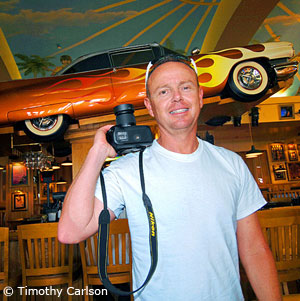
The life of a professional sports photographer appears to be absolutely thrilling and exciting and we spent some time with Rich Cruse to find out what it is really like to be in the middle of the action at so many historic triathlon events. We will also check in with a few other superb shooters moving forward, but today you will meet Californian Rich Cruse.
Slowtwitch: Rich, as a professional sports photographer you surely must be somewhere exciting right now.
Rich: I Wish! I am sitting in front of my computer at home! Waiting for the rain to stop so I can go on my daily walk.
ST: Are you ready for 2010?
Rich: 2010 looks like it will be better all around. The economy seems to be stabilizing and there are some great races out there.
ST: Any predictions?
Rich: Yes, I predict Lance Armstrong will not wait until 2011 to do Ironman, he will do it this year! He might even go to Maui for XTERRA!
ST: So how well will do you think Lance will do in Kona?
Rich: I just read his prediction via twitter – he said he could do it in 12 hours. I think he could do it in 9:30 or 10
ST: Have you set any goals for the New Year?
Rich: My goals are simple: do the best job I can, keep ahead of the curve with technology and do my best to reach as many new clients as possible.
ST: Quite a bit has changed in terms of technology since you have been involved. What sticks out in your mind?
Rich: Let’s see as an athlete, I think triathlons benefited most from the technological innovations supplied to US cyclists at the 1984 LA Olympics. Specifically, aerospace technologies like: carbon fiber and lightweight aluminum frames. Aero bars and helmets were also introduced. Shimano gave us the first “indexed shifting” (SIS) then shortly after STI, the integrated shift levers to compliment the indexed (click) shifting.
Lightweight helmets from Giro, Oakley Eyewear and Timex Ironman watches were all welcome additions. Look clipless pedals completed the picture.
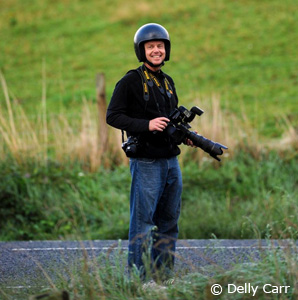
Camera wise, I am fortunate to have started when there were no autofocus, auto exposure or digital cameras. I say that because it gave me the experience I need to work through almost any situation today. I started with Olympus and then in 1988 I got the Nikon N8008 AF/AE camera with auto-balanced fill flash. This was a godsend because, as a slide shooter (which is what magazines required), the margin of error for exposure was very small. Slide shooting is by far the most difficult. For example, if your exposure is off 1/3 of an ƒ stop, your photo might not turn out, negative film (and now digital) has a 2 to 3 ƒ stop margin of error. Follow focusing manually was an art form. You would be lucky if you had 2-3 out of 10 images in focus.
In 1990, Mike Powell of All Sport introduced me to the Canon EOS 1. It was miles ahead of anything Nikon was doing. I knew I had to switch to be ahead of the game. By the end of the year, I had $15,000 worth of gear – thanks to a Canon lease to own program. I kept most of the same gear until 2004 when I added a Digital Rebel to the mix. It proved to be a great camera and saved me a fortune in film costs. I was hooked on digital and purchased the Canon 20D and used it until 2006.
ST: But you are a Nikon man now, is that correct?
Rich: Yes, in 2006, I had a difficult year in Kona. The race was dark and rainy and my exposures were all over the place. I had been waiting for Canon to introduce the 40D and it had not even been announced! I had a chance to see some images from Delly Carr taken at the same race and they were BEAUTIFUL! Obviously, Delly is a great photographer, but the quality of the images – especially the color was superior to anything I had seen from my Canons. Delly was using the latest Nikon camera – a D2x or something and I KNEW I had to switch.
I went to Maui the following week for XTERRA and purchased a Nikon D80 kit and flash for $1200 to test at the race. The images were so much nicer – I was sold! Next I bought a D200 and their 70-200mm VR ƒ2.8 lens, a wide angle and flashes. I have never regretted it. Now I have the D700, it is by far the best camera I have ever owned. I would love the D3S, but I don’t have the money to spend $5000 on one. The D700 costs $2700 and does everything I want. The light sensitivity is beyond belief. “If you can see it, you can shoot it” is basically how I feel using the camera.
I love digital because now, I have all film speeds at my disposal, the ability to review my images and fine tune exposure as I work.
ST: You have been around the triathlon world for quite some time both as an athlete and a pro photographer. When exactly did you stumble upon triathlon?
Rich: While I don’t remember the first Ironman on saw on TV, I of course remember the famous segment with Julie Moss crawling across the line in Kona. Her determination to finish at all costs deeply affected me (and thousands of others). I became aware of the USTS Bud Light Series through ads and in Triathlete Magazine soon after.
ST: We assume you do remember the first race you shot as a photographer.
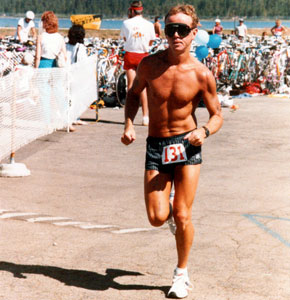
Rich: In 1986, I photographed the first Orange County Performing Arts Center Triathlon in Mission Viejo. Scott Tinley was there and I got his autograph! I remember how surprising it was to be able to meet the pros – not like in other sports. My first triathlon was the Bud Light USTS race in Solana Beach, CA in 1986. I raced as many as five races a year until 1990, all at Olympic distance or less.
I was photographing bicycle racing and the triathlons I wasn’t competing in. I would soon have to make a choice – compete or photograph triathlon. The choice was pretty clear. I was a middle of the pack age grouper and I felt more compelled to help promote the sport through my photography.
ST: How much gear do you schlep around at a big race and has that changed over the years?
Rich: I carry no more than will fit in my camera backpack. I want to be able to run if needed. My hands need to be free to climb over rocks or to hold myself steady. I carry 2-3 camera bodies, 2 flashes, wide-angle zoom, mid-range zoom and my 70-200mm.
ST: Do most of the photographers get along fine during the races or is there somewhat of a fight for position and location?
Rich: It used to be a friendlier atmosphere. I think most would have their clients already set before they arrived. Competition has become so intense that it makes it difficult for anyone to make a living. I sometimes feel more like a paparazzi (and lately we tend to get treated like them). I get 50% less for images now than I did 10 years ago!
ST: Is getting less money now a sign of the economy or more so about more competition?
Rich: Yes and no, digital has brought photography to the masses, they are less willing to pay for quality. Also, the new cameras make it easier to reach a certain level of proficiency in a short about of time with a small investment. What makes a pro valuable is the ability to anticipate action and execute.
ST: Have you been involved in any physical contact for space, ie finish line images?
Rich: I have and this is happening more and more. Race organizers are treating photographers more like paparazzi and I can tell you that it creates a different atmosphere. All I can say is that there is no longer a comraderie between photographers where they stay out of each other's way. They will sometimes knowingly block you- just like paparazzi do. Real journalists don’t work that way.
ST: Which photographer do you admire the most?
Rich: Without a doubt Delly Carr! He is insightful, honest, caring, talented and he doesn’t rely on a lot of gadgets or Photoshop filtering – his images are magic! Besides all that, he is a great guy!
ST: Of all the races you have shot, do any specific events stick out as more memorable and can you tell us why?
Rich: I would say there are two- both Kona, the race between Mark Allen and Dave Scott in 1989 was amazing. I was privileged to witness it firsthand.
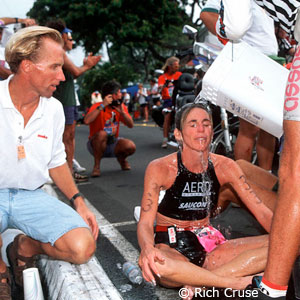
The other is 1995 when Paula Newby Fraser collapsed within sight of the finish line. We were all waiting for her and she seemed to have it in the bag. Next thing we know, Karen Smyers crosses the line with Paula nowhere in sight! I hear a whisper she had collapsed just up the road, so I took off running with all my gear hanging off me. It had to be quite a scene watching me. It was a few hundred yards away!
When I got there, I saw Paul Huddle frantically trying to get help using his cell phone. Paula looked as white as a sheet. After someone poured a bucket of water on her, she began to come back to life.
I got some good images and was mindful and respectful of her situation. It is my job to record these things.
ST: What about the athletes themselves, are there any of Pros who are easier or more fun to work with?
Rich: I have always enjoyed being around the athletes. Getting to meet and work around and with my heroes is the best part of the job. Mark Allen, Scott Tinley, Dave Scott, Greg Welch, Conrad Stoltz and Jimmy Ricitello come to mind. Michellie Jones was always nice as was Paula and Karen Smyers. With few exceptions, triathletes are the most easy going and fun loving group you’ll find in the sports world.
I would have to say Conrad Stoltz has been the most fun to work with!
ST: Are there any Pros who aren’t nice?
Rich: Hehe – If there were, I would never say it. I want to work!
ST: Along those lines have you ever captured something with your camera during a race that an athlete asked you to not show because it might be trouble causing?
Rich: Nothing specific comes to mind. I am sure I have been asked to leave out images that may show equipment failure from time to time. I am independent. I do not seek to damage someone’s reputation with my images, only to tell the truth.
ST: Who will win Kona in 2010?
Rich: Macca or Lieto. Chrissie is tough to beat
ST: What about Alexander?
Rich: I think all three are in the running – plus there may be someone out there we don’t know about. The reason I give Macca and Lieto the nod is that I think each of them have been studying Craig and are close figuring out what it takes to beat him. Macca has already done it. Lieto has made huge strides and he might just do it in 2010!
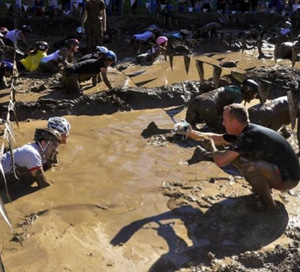
ST: Do you still compete in triathlons?
Rich: I would like to – Achilles problems has limited my ability to run, now I fitness walk. Should the opportunity to a do Ironman in Kona ever come, I would do it and finish. That’s a promise. For now, I am more than happy to keep involved through my photography.
ST: How bad is your diet when you are on the road?
Rich: I was on a strict Atkins diet for a number of years, but it was difficult to maintain on the road. I would have to bring Atkins energy bars and nuts for food. Now I am more concerned about calories. I eat what I want, but not too much!
ST: How about at home?
Rich: Higher protein, lower carbs mostly.
ST: What was the last book you read?
Rich: 😉 Bob Babbitt’s 30 Years of Ironman!
ST: Do you follow other sports?
Rich: I like cycling, basketball, mountain biking and football.
ST: Where do you see yourself in 5 years?
Rich: I know photography will always be a part of who I am. This is a job I do because I love it, not because it is making me rich. I will shoot as many races as feasible in the coming years. Funny, 10 years ago my Dad told me "You’re not going to be able to do this much longer." Here I am 10 years later and I am certain I could do this for 10 more years- easy!
Being involved in triathlon has taken me to points all over the world: Japan, Saipan, Bermuda, St. Croix, Hawaii and Guam. I would not trade these experiences for anything. I am so lucky to have had the opportunity.
ST: Is there anything else we should know about you?
Rich: I take my job seriously. What I mean is that I work very hard to accurately portray events as they really looked. I am always fair and try to be unbiased in my approach. There are too many people playing free and easy with Photoshop and gadgets; I would love to see magazines enact strict guidelines on what is appropriate for race photography. With my images, it is all WYSIWYG!
(ed) You can find "What You See Is What You Get" at richcruse.com



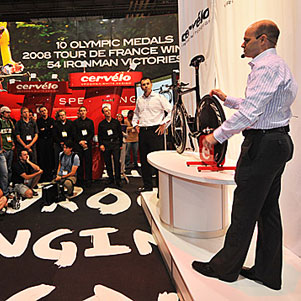
Start the discussion at slowtwitch.northend.network